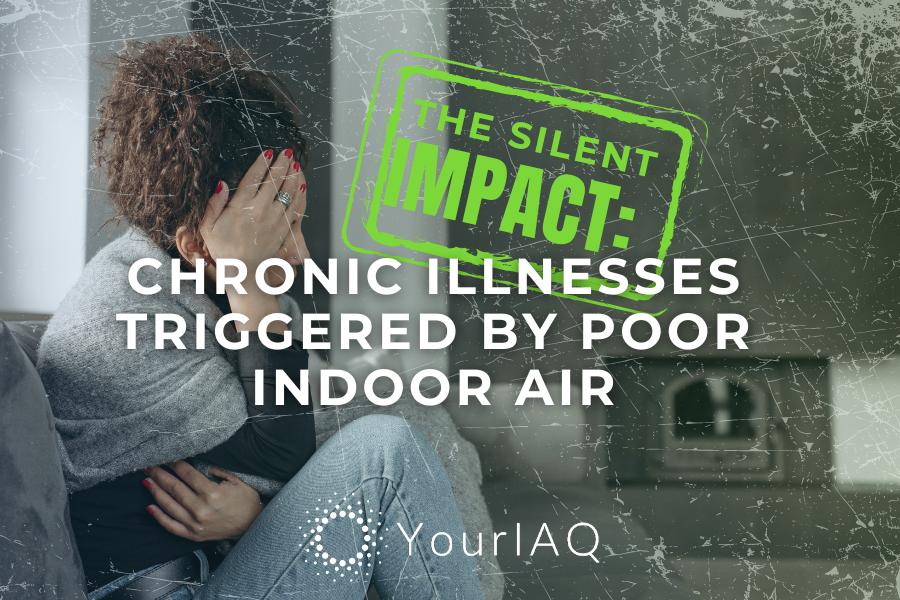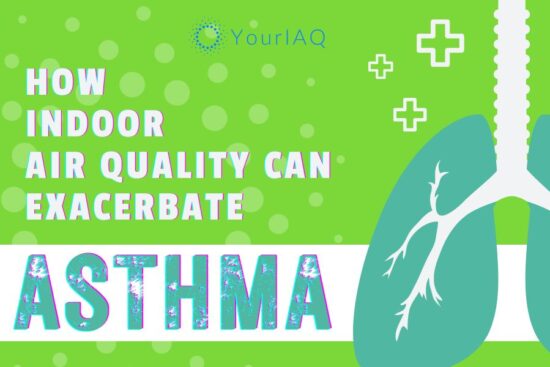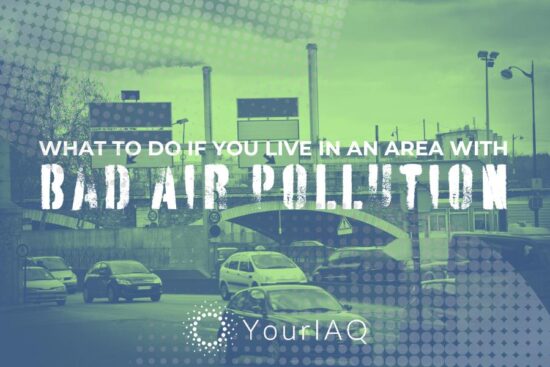
Shockingly, nearly 99% of the global population breathes polluted air, and the air inside our homes can be 2 to 5 times worse than outdoors. This is particularly concerning for children and other vulnerable groups like pregnant women, older adults, and individuals with chronic illnesses, who spend up to 90% of their time indoors. In this comprehensive guide, we’ll unveil the diverse health effects of indoor air pollution, from respiratory issues and heart disease to developmental delays in children.
Health Effects of Indoor Air Pollution
The dangers of indoor air pollution go far beyond fleeting discomfort. Microscopic culprits like particulate matter infiltrate our lungs, triggering a cascade of harm, including:
Chronic Inflammation and Oxidative Stress
Exposure to indoor air pollutants leads to chronic inflammation and oxidative stress, which can significantly worsen existing conditions like chronic obstructive pulmonary disease (COPD), asthma, and chronic bronchitis and increase the risk of developing heart disease and even lung cancer. Studies have shown that exposure to nitrogen dioxide (NO2), commonly emitted by gas stoves and unvented heaters, is linked to an increased risk of childhood asthma and impaired lung development.
The World Health Organization (WHO) estimates that indoor air pollution claims the lives of 3.8 million people each year, mostly women and children in low- and middle-income countries. As Dr. Margaret Chan, former WHO director general, poignantly stated, “Indoor air pollution is a serious environmental health hazard.”
| What Does Chronic Inflammation and Oxidative Stress Even Mean?
Imagine your body is like a city. Normally, your immune system acts like firefighters, rushing to put out any fires (infections) that flare up. But in chronic inflammation, it’s like the fire alarm keeps going off even when there’s no fire. This constant “alarm state” damages buildings (tissues) over time, making it easier for disease to take hold. Conversely, oxidative stress occurs when harmful molecules called free radicals outnumber the body’s antioxidant defenses. The imbalance leads to cellular damage and dysfunction, contributing to aging and various chronic diseases. Indoor air pollutants like particulate matter and nitrogen dioxide significantly raise free radical levels, tipping the scales towards oxidative stress. This increased burden on your cellular defenses damages DNA, a potential first step in the development of cancer. |
Lung Function Decline and Lung Cancer
Lung Function Decline
Studies have shown a clear link between indoor air pollution and a decline in lung function, impacting your ability to breathe deeply. This is particularly concerning for children and vulnerable populations with existing respiratory conditions like asthma.
Here’s the evidence:
- Worsening Asthma: Research suggests that exposure to indoor air pollution from gas cooking appliances worsens asthma symptoms, including wheezing and reduced lung function, in children. This effect is even more pronounced when ventilation is inadequate or the child already has asthma or allergies.
- Wood-Burning Impact: Home heating with wood significantly increases indoor levels of harmful fine particles (PM2.5), black carbon (soot), and toxic chemicals like dioxins, Polycyclic aromatic hydrocarbons (PAHs), and volatile organic compounds (VOCs). Studies estimate wood burning can contribute up to 90% of local particulate matter pollution in smaller communities. These microscopic particles penetrate deep into the lungs, harming lung function, increasing the risk of respiratory problems, and potentially leading to other health complications.
- Long-Term Effects: Even moderate exposure to indoor air pollution over time can gradually decline lung function. According to the American Lung Association, even healthy adults living in homes with gas stoves experience a decline in lung function comparable to smoking a pack of cigarettes per year.
Lung Cancer
Long-term exposure to radon and formaldehyde, commonly found in homes and buildings, has been linked to an increased likelihood of developing lung cancer.
Radon, a radioactive gas that seeps from the soil and rocks, enters our homes through cracks and openings. After smoking, radon exposure is the second leading cause of lung cancer in the United States, responsible for an estimated 21,000 lung cancer deaths annually.
Similarly, formaldehyde, a chemical found in building materials and household products, has been classified as a known carcinogen by the International Agency for Research on Cancer (IARC). Studies have shown an association between long-term exposure to formaldehyde and an increased risk of lung cancer, particularly in people who also smoke.
Related reading: How Indoor Air Quality Affects Lung Health
Weakened Immune System
While we often think of viruses and bacteria as the sole culprits behind infections, indoor air pollution throws a wrench in the body’s natural defense mechanisms. Studies suggest exposure to particulate matter and VOCs can:
- Reduce white blood cell activity: These are the soldiers of our immune system, responsible for recognizing and fighting off pathogens. Pollution hinders their ability to produce antibodies and engulf invading microbes, leaving us vulnerable.
- Damage to immune system organs: Organs like the spleen and lymph nodes play crucial roles in immune function. Pollutants infiltrate these tissues, disrupting their ability to generate immune responses.
- Increase inflammation: Chronic exposure to indoor air pollution triggers low-grade inflammation throughout the body. This inflammatory response, while meant to ward off threats, actually weakens the immune system’s specific response to infections.
Developmental Delays in Children
The Environmental Protection Agency highlights the concerning impact of indoor air pollutants like lead, found in dust from old paint and contaminated soil, and PAHs, emitted from burning tobacco and incense, on children’s cognitive and physical development.
Lead Exposure
Lead exposure from sources like old paint and contaminated soil has dire consequences for children, particularly impacting their cognitive development. Studies have shown that:
- Nearly half of all childhood lead poisoning cases in the United States are estimated to be attributed to lead-based paint, which is present in over 87 million pre-1978 homes nationwide. (Source: Environmental Protection Agency)
- Even low levels of lead exposure (as low as 5 micrograms per deciliter of blood) can negatively affect a child’s IQ, with each 10-microgram/dL increase in blood lead level associated with a 4-7 point decrease in IQ. (Source: Centers for Disease Control and Prevention)
- Children with elevated blood lead levels are 4 to 6 times more likely to experience learning difficulties and have a 50% higher risk of attention deficit hyperactivity disorder (ADHD). (Source: World Health Organization)
- The economic impact of childhood lead poisoning is estimated to be over $43 billion annually in the US alone due to lost productivity and increased healthcare costs. (Source: Institute for Policy Integrity)
Polycyclic Aromatic Hydrocarbons (PAHs)
These harmful compounds are emitted from burning tobacco and incense, as well as certain appliances. Studies have linked PAH exposure in children to an increased risk of developing asthma later in life.
Cardiovascular Diseases
In addition to respiratory issues, indoor air pollution also has detrimental effects on our cardiovascular system. Fine particles and harmful gases enter our bloodstream and contribute to the development of cardiovascular diseases.
- Heart disease: Fine particulate matter (PM2.5) and other air pollutants enter the bloodstream and contribute to the development of heart disease, stroke, and high blood pressure. Studies have shown that participants exposed to household air pollution were 17% more likely to have developed hypertension compared to those who were not. This highlights the direct link between poor air quality and increased risk of cardiovascular issues.
- Stroke: Similar to heart disease, air pollution increases the risk of stroke by affecting blood pressure and clotting mechanisms.
The harmful effects are particularly pronounced in individuals with underlying heart conditions and those who are exposed to high levels of pollutants for extended periods.
Important Note:
The World Health Organization (WHO) advises keeping indoor PM2.5 levels below 5 micrograms per cubic meter (μg/m3) year-round and 15 μg/m3 in any 24-hour period for optimal health.
Beyond Illness: The Holistic Impact of Indoor Air Pollution
The impact of this silent threat extends beyond specific diseases, affecting our:
Microbiome
Indoor air pollutants disrupt the delicate balance of gut bacteria, potentially impacting digestion, immunity, and overall health.
Mental well-being
Studies have found links between exposure to indoor air pollution and symptoms of anxiety and depression.
Related article: Air Quality and Mental Health: The Unseen Connection
Quality of life
Prolonged exposure to polluted air can lead to fatigue, decreased cognitive function, and a general decline in well-being, which could manifest as symptoms such as:
- Headaches
- Dizziness
- Fatigue
- Nausea
- Eye irritation
- Skin irritation
- Difficulty concentrating
These symptoms sometimes arise from a condition known as sick building syndrome, caused by exposure to a combination of indoor air pollutants and inadequate ventilation.
Sources of Indoor Air Pollution
The sources of this silent threat are surprisingly diverse:
- Gas Stoves: These common kitchen appliances are major emitters of nitrogen dioxide and carbon monoxide, known risk factors for respiratory issues and cardiovascular disease.
- Molds and Dampness: Damp environments are breeding grounds for fungal spores, triggering acute respiratory infections and allergic reactions.
- Dust Mites: Microscopic creatures thriving in warm, humid environments causes sneezing, wheezing, and itchy eyes.
- Volatile Organic Compounds (VOCs): Emitted from furniture, paints, and cleaning products, VOCs cause headaches, dizziness, and even neurological damage.
- Heavy Metals: Lead, arsenic, and other heavy metals enter homes through contaminated soil or building materials, leading to a range of health problems.
Taking Back Control: Your Toolkit for Cleaner Air
You’re not powerless against this invisible enemy. Here are steps to take control of your indoor air quality:
Step #1: Invest in HEPA-filtered air purifiers.
Choose an appropriate Clean Air Delivery Rate (CADR) for your room size, as recommended by the EPA.
Step #2: Improve ventilation.
Regularly open windows and doors to allow fresh air to circulate. Aim for at least 10 air changes per hour, according to the World Health Organization.
Step #3: Eliminate sources of pollution.
Replace gas stoves with electric ranges, address mold and dampness promptly, and choose low-VOC furniture and cleaning products.
Step #4: Quit smoking and discourage smoking inside your home.
Protect yourself and others from the dangers of environmental tobacco smoke.
Related reading: How Smoking Affects Indoor Air Quality and Health
Step #5: Monitor indoor air quality levels.
Use sensors and apps to track particulate matter, VOCs, and even carbon dioxide levels.
Step #6: Test for Radon
Radon is a silent but dangerous indoor air pollutant. Testing your home for radon is essential to identify any potential risks. Radon test kits are readily available and easy to use.
Step #7: Regularly Maintain HVAC Systems
Heating, ventilation, and air conditioning (HVAC) systems play a significant role in maintaining indoor air quality. Regularly clean and replace filters to ensure they are functioning effectively.
Consider scheduling professional maintenance to address any potential issues and optimize the performance of your HVAC system.
Step #8: Seek Professional Help
If you have persistent indoor air quality issues or concerns about specific pollutants, consider consulting with a professional. Indoor air quality assessments help identify sources of pollution and provide tailored recommendations to improve your indoor environment.
Collective Action for a Cleaner Future: Advocating for Change
Fighting indoor air pollution isn’t an individual battle. It’s a collective responsibility. We can advocate for stricter indoor air quality standards in homes, workplaces, and public spaces. This includes supporting initiatives by government agencies like the EPA and the Department of Housing and Urban Development (HUD) in the US and similar organizations globally.
Additionally, professional associations like the Indoor Air Quality Association (IAQA) and the American Public Health Association (APHA) play a crucial role in raising awareness and pushing for regulations.
The fight for cleaner air is not an individual battle but a collective responsibility. By understanding the diverse health effects, identifying sources, and taking proactive steps; we can breathe easier, live healthier, and create a cleaner future for ourselves and future generations.
FAQs on Health Effects of Indoor Air Pollution
Can I improve the air quality in my home?
Absolutely! Invest in air purifiers, improve ventilation, eliminate pollution sources, and monitor
Should I buy an air purifier?
Air purifiers with HEPA filters can significantly improve indoor air quality, especially in enclosed spaces with limited ventilation. Choose one with a CADR appropriate for your room size.
How often should I open windows for ventilation?
Regularly opening windows for 10-15 minutes at a time is a good practice, especially after activities that generate pollutants, like cooking or cleaning.
What are some natural ways to purify indoor air?
Houseplants like peace lilies and snake plants can help filter out some pollutants. Regularly vacuuming and dusting also contribute to a cleaner environment.
Who should be especially concerned about indoor air quality?
Children, pregnant women, people with existing respiratory conditions, and older adults are more vulnerable to the health effects of polluted air.
What can I do to advocate for cleaner air?
Support initiatives for stricter indoor air quality standards in homes, workplaces, and public spaces. Contact your local elected officials and environmental organizations to voice your concerns.






